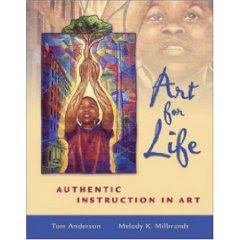- Both focus on means of expression
- Both use symbols
- Both employ similar methods of critical analysis and interpretation
Drawing before writing forces the child to recall and decide on the details that enrich the writing
- encourage students to draw something that is meaningful to them, on a topic they choose - then ask them to write about it
- the drawing and the accompanying talk give the naturally curious young child access to other children's minds and feelings
Drawing is critical to the early development of language and narritive
- Learning to draw requires close observation skills - skills that catalyze thinking skills
THE VOCABULARY OF ART
- Vocabulary development is a major factor in success in reading
- The formal elements reflect potential vocabulary for description or representation
- Have students describe characteristics of lines
- Have students compare/contrast shapes and forms
- Art can be used to give visual expression to what adjectives express verbally
- Making art and talking about what they have made allows children to expand their ability to communicate in alomost endless ways
SPEECH, THOUGHT, AND ART - use art to promote Language Arts goals
- Illustrate a story - illustrate a character or a scene
- Keep a journal - for writing and drawing
- Write a poem or essay about an artwork
- Talk about a memory
- Write a story
- Learn to "read" pictures
Visual Literacy - the ability to analyze and interpret visual images
THINKING CRITICALLY ABOUT AND THROUGH ART
- Speech development and the ability to think critically are fostered by conversations about art
- Give students a chance to tell you what the see and feel
- Working in groups facilitates language development
THE ART OF LANGUAGE: COMMONALITIES BETWEEN DESIGN STRUCTURES IN LANGUAGE AND ART
- Metaphors, representation, variation, symmetry, dominance, and emphasis - design elements that can be used in writing, i.e. figures of speech, alliteration, etc.






No comments:
Post a Comment